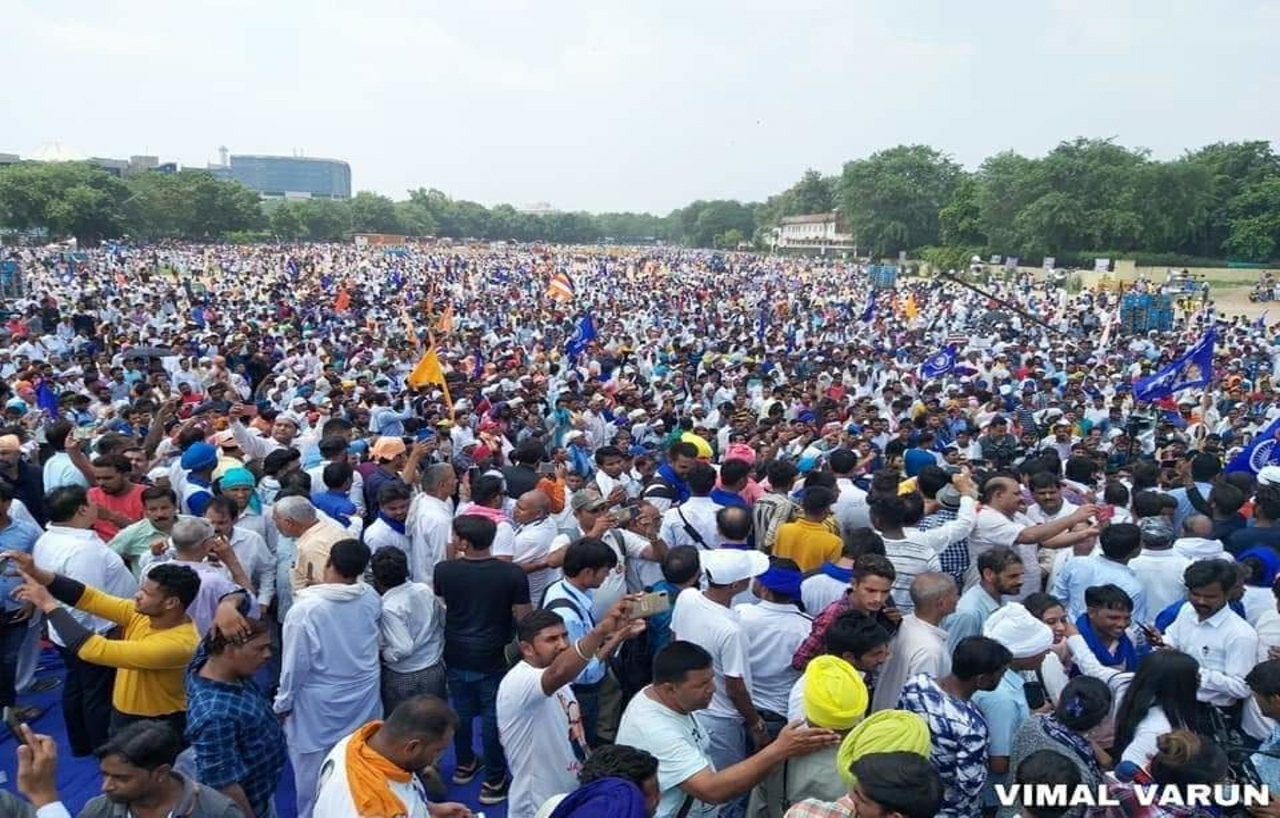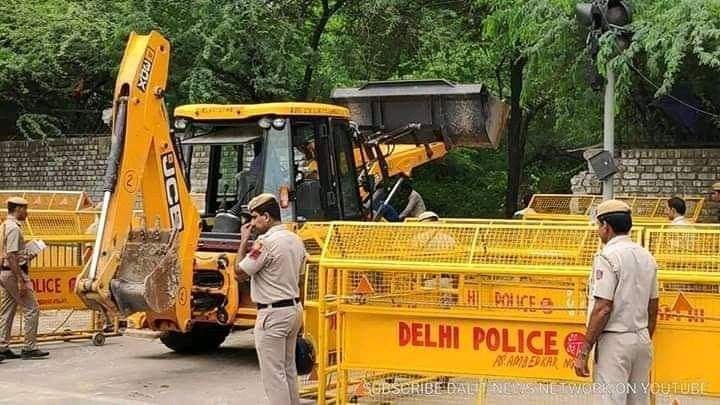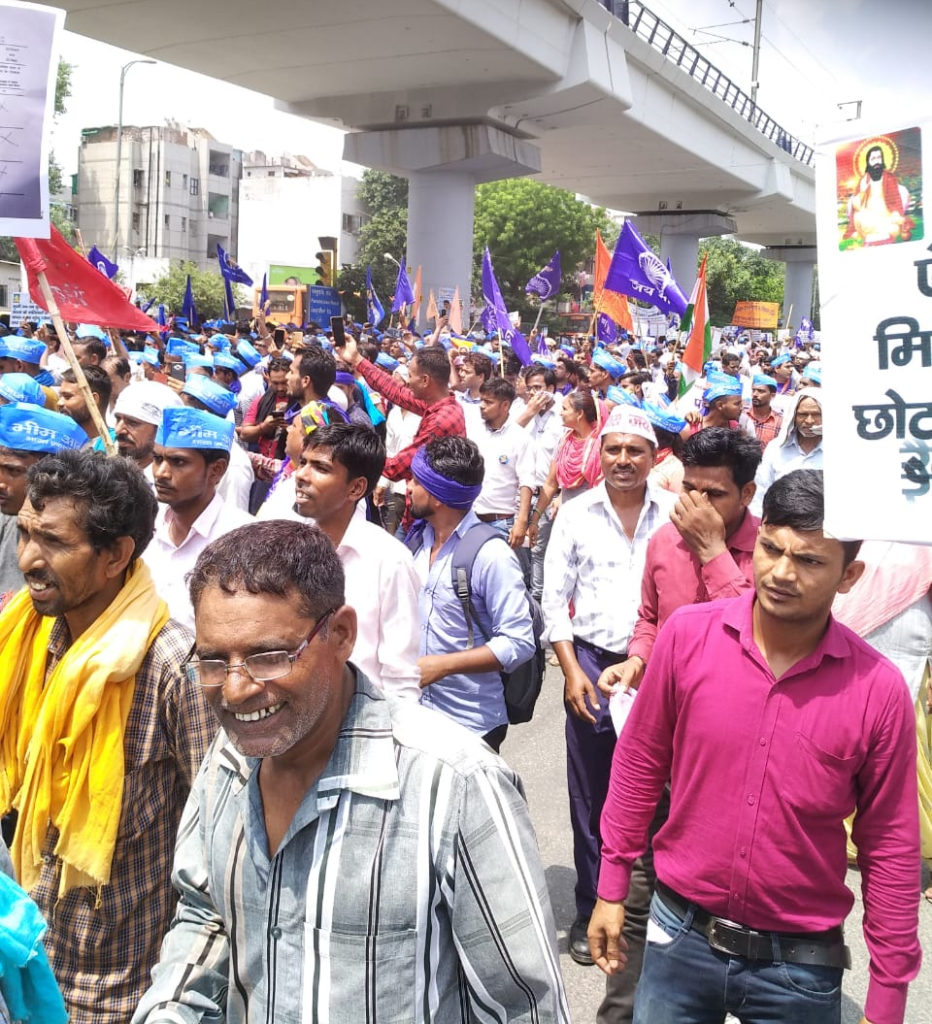Several Dalit protestors and leaders have been arrested after demonstrating against the demolition of a temple of anti-caste crusader Sant Ravidas in Delhi. Dalit organisations have warned the Government, if those arrested are not released, the Bahujan Samaj will call for a Bharat Bandh. A Groundxero report.
The Ravidasi community is agitating against demolition of a Sant Ravidas Mandir in Delhi. On 21st August the protests saw brutal police crackdown with lathicharge and teargas. The police arrested around 96 protestors including the Bhim Army Chief Chandrashekhar Azad and National President Vinay Ratan. The Bhim Army has given an ultimatum of 10 days – if the government does not pass an ordinance for the reconstruction of the demolished Ravidas Mandir then, the Bahujan Samaj will call for a Bharat Bandh.
On the day the city of Delhi came to a standstill as thousands of Dalit persons marched from Ramlila Maidan to Tuglaqabad area where the Mandir was located. The demolition is being perceived as an attack on the self-respect of the Ravidasis. Ravidasis from Punjab, Haryana, Uttar Pradesh and other states arrived to make their voice heard. After leaders at the Ramlila ground declared that they would reinstall the Sant Ravidas’s statue at the original site, the protestors started marching towards the site where the temple earlier stood. Delhi police tear-gassed and beat up the protestors and 96 of them were arrested.
The Bhim Army in a press release condemned the police crack down and termed the Central Government’s move as fascistic. The press release also mentions that Azad and Vinay Ratan was tied up and severely beaten in custody. Next day when Azad was presented in the court he could barely walk. The court ordered a 14 days judicial custody to the detainees. The Dalit organisations termed 25 August as Black Day and will continue to protest till the police does release the arrested people.
On August 9, the Supreme Court instructed the Delhi Development Authority (the Central Government-controlled organisation responsible for urban planning and development in the capital) to demolish the temple and clear out the grounds with “the help of the police”. The shrine was razed the very next day.
For decades, the DDA had been fighting to demolish this Ravidas temple. Around thirty years ago, led by the Guru Ravidas Jainti Samroh Samiti, the temple management took legal cause in order to prevent the demolition. However, the DDA argued in the court that there were no records to prove the ownership of the temple management and claimed the constructions were made on “green land” (protected forest area) and are hence illegal. The court also observed that the temple Samiti could not ‘prove’ its ownership and that after Central Government acquired the land under Land Acquisition Act 1963, it was transferred to DDA. Though the Ravidasis claim that the temple is 600 years old, the land was gifted to them by Sikandar Lodhi of the Delhi Sultanate who himself became a follower. “While these people can fight cases for decades in order to build their own Ram Temple, they have no shame in demolishing our Ravidas Temple. These people hate us,” said one protestor at the rally.
Media black out
On 23rd August, the Women’s Press Club in Delhi cancelled the booking for a press meet on the issue of police violence on the protestors. The booking was cancelled citing that the Press Club does not hold “political or religious meetings”, though the Bhim Army is neither a political party nor a religious organisation. A hand-written statement issued by the Bhim Army organisers has claimed that they have information that the booking was cancelled due to pressures from the police administration.
Even one of the largest Bahujan rallies in Delhi in recent times, and subsequent police repression, did not make it into the upper-caste controlled media rooms.
An anti-caste crusader
The political consciousness of the so-called ‘Chamar’ community [identity and name imposed by Brahmans] – the largest Dalit group of Northern India – runs parallel to the development of the Ravidasi religious identity. This 16th century spiritual leader’s teachings have been also included in the Guru Granth Sahab. Guru Ravidas was contemporaries with other anti-caste reformers like Guru Nanak and Sant Kabir, and they have been known to have met and exchanged ideas and philosophies. The August 10 demolition was an attack on the Ravidasi identity of these communities. On August 13, a bandh was held in Punjab (where nearly 10% of the population is Ravidasi) in protest. A week later, a collective protest was called by the All India Ravidasia Dharm Sangathan and the Bhim Army, at Delhi’s Ramlila Maidan.
An article in Round Table India mentions, “The most problematic aspect of the demolition of the Guru Ravidas temple was the manner in which it was motivated and undertaken. The demolition was ordered by the Supreme Court by the order of judges, namely Justice Arun Mishra and Justice M. R. Shah who have a history of going against the oppressed castes. We have seen in several other previous judgments such as the weakening of the SC/ST Atrocities Act and the order regarding changing of the 200 point roster that guided the reservation among the teaching posts in higher educational institutions, that these judges are not sympathetic to the cases of justice for the people from Scheduled Castes and Scheduled Tribes. Presence of casteist forces at the highest court in the judiciary is a significant problem.”
The article also mentions,”many Dalit scholars believe that systematic cultural revolution from within the marginalized communities can counter the prevalence of brahmanical ideas. And structures like the Ravidas temple, Ambedkar Bhavan, Bhagwan Valmiki Mandir provide the necessary spaces of building cultural and political consciousness for this counter action. Therefore, the right wing can never accept these spaces.”
Sant Ravidas who was himself born to leather-worker parents, launched direct attack on the spiritual hegemony of Brahmins, denouncing the Vedas and their claimed authority. “Charon ved kiya khandoti, Jan Ravidas kare dandoti [I, Ravidas, proclaim all Vedas are worthless],” he said. While on the one hand exposing the fallacies of the Brahmanic propaganda, Guru Ravidas propagated a socio-religious alternative to the labouring masses that would seek equality for all human beings and require no religious rituals. He was an accomplished poet whose couplets are still sung among the toiling masses of this country. He has also been claimed to be the inventor of the Gurumukhi language as active opposition to Sanskrit that was monopolized by Brahmins and declared as taboo even for other caste-Hindus.
Begumpura
The regal realm with the sorrowless name:
they call it Begumpura, a place with no pain,
No taxes or cares, none owns property there,
no wrongdoing, worry, terror, or torture.
Oh my brother, I’ve come to take it as my own,
my distant home where everything is right.
That imperial kingdom is rich and secure,
where none are third or second – all are one;
They do this or that, they walk where they wish,
they stroll through fabled palaces unchallenged.
Oh, says Ravidas, a tanner now set free,
those who walk beside me are my friends.
Sant Ravidas’s poem “Begumpura” from the book Songs of the Saints of India, edited by Hawley and Juergensmeyer [page 32].
Gail Omvedt in her book, Seeking Begumpura, writes “It (Begumpura poem) was an expression, in the early modern age, of a utopia, perhaps the first one in Indian literature. In some ways it seems to stand alone, yet it was a harbinger – of the kind of social vision that would underlie all the later struggles and theorizing of anti-caste intellectuals. Begumpura was, for Ravidas, an imagined city, without geographical location, without a history: it was to be a later task to build it in space and time.”



